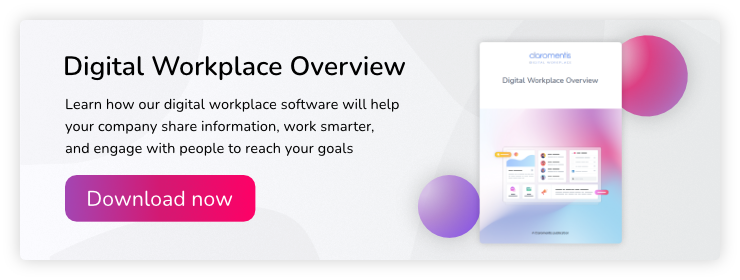A unified digital workplace strategy is not a one-size-fits-all tool – it’s an evolving template for aligning different organizational and individual expectations into a shared vision that drives growth while maintaining high employee engagement.
As remote work becomes the rule, rather than the exception, companies need to implement effective digital workplace strategies that enhance employee experience and enable team members to collaborate seamlessly to focus on delivering a high-quality customer experience.
This guide outlines three simple steps to create a winning strategy that will help you align your digital workplace objectives.
Step one: identify the current digital workplace problems and define your business needs
The first critical step in creating a winning strategy is to analyze your current environment, identify existing problems, and define your business needs. Highlighting these three items helps you determine the kind of unified digital workplace platform your organization requires and what features will solve the issues identified.
Deploying digital workplaces to adopt new technology and not address specific issues only results in bloatware that’s expensive to maintain.
Start by engaging all departments to understand their pain points, goals and how the digital workplace platform can enhance their processes.
Next, review your organization’s short and long-term strategy to identify what areas could be accelerated or improved with a unified platform. By establishing all the primary factors, you’ll have a good benchmark for measuring the success of the unified digital tools you intend to implement.
Here are some core features to look out for in a unified digital workplace platform that are directly tied to business needs:
- Knowledge management: If most of your teams work remotely, having a central repository for unifying corporate knowledge and data will improve collaboration, version control and employee experience.
- Instant messaging: A performance digital workplace platform should have an instant messaging feature to facilitate social interactions between employees, away from official channels like email. This is because social interactions foster productivity, connection and increase employee engagement.
- Intuitive user experience: Remote working already has its fair share of challenges, so you need to ensure your platform has an enjoyable and intuitive user interface. Infuse AI-powered search to research information, add different media types to enhance accessibility and increase customization options. You want to give remote employees a personalized experience that they can look forward to every time they log into the platform.
Step two: create an implementation plan
Implementing a new virtual space technology is more than installing and configuring software. It helps to have a well-laid plan that does not affect business continuity or diminish employee productivity.
Adding a new digital workplace platform requires time and careful planning to avoid costly mistakes. Establish the resources needed and communicate team roles to plan the implementation process early.
Resources required will differ depending on the scale of digitization you’re aiming for. If it’s a total transformation, establish the networking tools required, hardware, cloud platforms and if you’ll still need office space. If it’s a phased implementation, set the implementation period and what milestones you need to measure for each installation.
The implementation plan also needs to highlight the scope of the new digital tools based on whether your company operations are centralized or decentralized. In a decentralized workforce, employees are in different locations, meaning you’ll need to consider security, data regulations and time zones.
In both scenarios, you will need to determine how communication and collaboration will take place to establish the level of customization and additional features required in a unified digital workplace.
In general, implementing digital tools of such scale requires high employee engagement and agile project management skills to undertake a successful transformation that enhances the current workplace productivity.
Software deployments are best done in short, iterative cycles, so you don’t carry over issues from previous implementation cycles. It also allows you to conduct proof of concept before full implementation so that you can resolve bottlenecks at a much smaller scale.
Also, the implementation may take weeks or months, depending on the organization size and scope of the unified digital platform. Bear this in mind to manage deadlines and stakeholder expectations.
Step three: long term planning
The final step comes after successfully implementing the digital workplace platform, and it is operational. Beyond the usual maintenance, you need to consistently enhance the unified virtual space to meet business challenges, enhance employee engagement and support the overall growth strategies.
Long-term planning involves looking at the newly implemented platform and deciding at what intervals you’ll review its performance to identify areas of improvement. For example:
- Do you want to add more features in the future?
- How often will you assess performance?
- How do you integrate third-party apps and multiple applications?
- What are the policies required to govern the digital workplace?
- How do external users interact with the platform?
- Is there a new user engagement strategy?
- How often will you refresh the platform?
- What are the security measures required to safeguard access points?
- How will the digital workplace integrate with your existing intranet?
- Who are the information workers in charge of maintaining the knowledge repositories?
These are some of the questions you need to consider in your long-term strategy to derive the most value from your digital workplace. The bottom line is that you need to review your digital platform regularly to ensure it meets its expectations.
A unified digital workplace is an ongoing project that should evolve as your organization grows. It’s not just a set of tools but a strategic addition to making your employees’ jobs more manageable, collaborating seamlessly and improving the overall customer experience. It’s also a robust knowledge management platform for enhancing internal communication, driving engagement and defining company culture.
What next?
Now that you’ve defined a strategy, create an implementation roadmap with timelines and communicate the expectations to everyone involved. Ensure you provide realistic timelines that do not rush the process and give ample time for testing and configurations.
To learn more about implementing a digital workplace, download our free guide for How to Create an Intranet Strategy in 3 Simple Steps.






